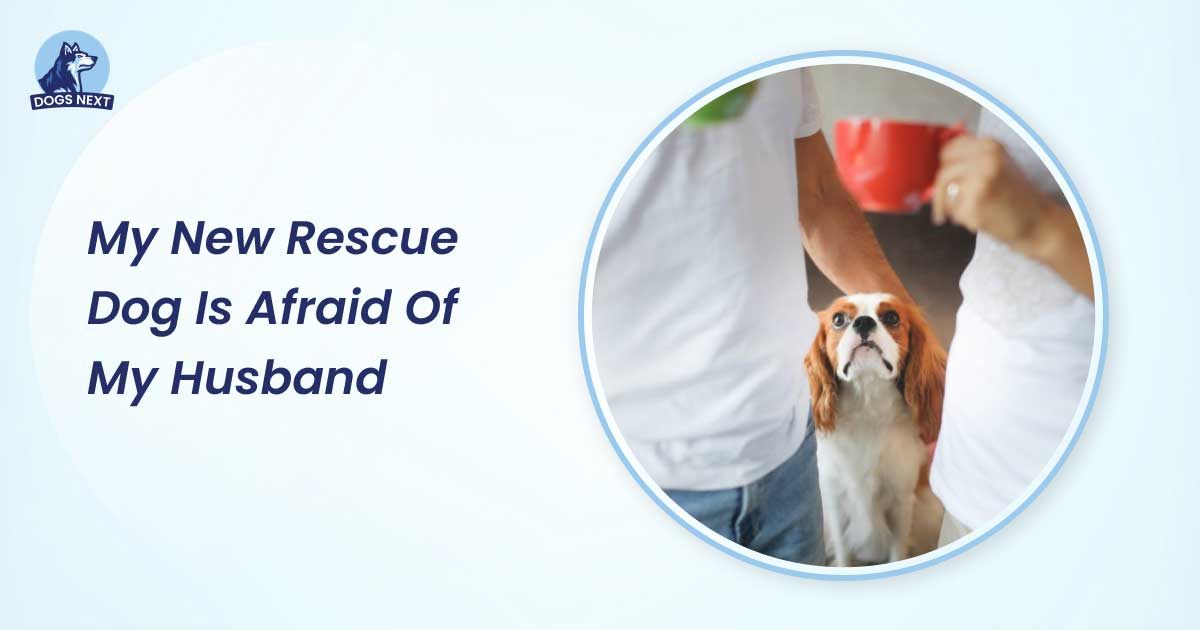Your new rescue dog is likely afraid of your husband due to past trauma or lack of socialization. Patience and gradual introduction can help ease their fears.
Welcoming a rescue dog into your home is both rewarding and challenging. Many rescue dogs come with a history of neglect or abuse, making them wary of new people, especially men. Your dog’s fear of your husband could be rooted in such past experiences.
It’s important to approach the situation with empathy and patience. Creating positive associations with your husband through treats, gentle interactions, and a calm environment can help. Consistent routines and gradual exposure will build trust over time. Remember, every dog adjusts at their own pace, so stay patient and supportive throughout the process.
Fear In Rescue Dogs
Bringing home a new rescue dog is an exciting experience. But what if your furry friend is afraid of your husband? Fear in rescue dogs is a common issue. Understanding the causes can help you create a safe and loving environment for your pet.
Why Rescue Dogs May Be Fearful Of Specific People
Rescue dogs may have had difficult pasts. These experiences can make them wary of specific people. Here are some reasons why your dog might be afraid of your husband:
- Past Trauma: Dogs that have faced abuse may fear men who resemble their abusers.
- Limited Socialization: Dogs who haven’t met many people may find men intimidating.
- Previous Neglect: Dogs that were neglected may not trust people quickly, especially men.
- Size and Voice: Men are often larger and have deeper voices, which can scare some dogs.
Understanding these reasons can help you address your dog’s fear. The table below highlights the common causes and possible solutions:
| Cause of Fear | Solution |
|---|---|
| Past Trauma | Gentle and consistent positive interactions |
| Limited Socialization | Gradual exposure to different people |
| Previous Neglect | Building trust through daily care and affection |
| Size and Voice | Soft spoken approach and gentle body language |
Common Triggers That May Cause Fear Of Men
Several triggers can make rescue dogs afraid of men. Identifying these triggers can help manage and reduce their fear.
Here are some common triggers:
- Sudden Movements: Quick, unexpected movements can startle dogs.
- Loud Voices: Deep, loud voices may seem threatening.
- Direct Eye Contact: Staring can be interpreted as a challenge.
- Strong Scents: Strong cologne or aftershave can be overwhelming.
- Body Language: Large gestures can appear aggressive.
To help your dog feel safe, try the following strategies:
- Move Slowly: Avoid sudden movements around your dog.
- Speak Softly: Use a calm, gentle voice when talking to your dog.
- Avoid Direct Eye Contact: Look to the side rather than staring directly at your dog.
- Limit Strong Scents: Avoid wearing strong colognes or aftershaves.
- Use Gentle Gestures: Keep your movements slow and controlled.
By understanding and addressing these triggers, you can help your rescue dog feel more comfortable and secure in their new home.
Recognizing Fearful Behavior In Your Dog
Bringing a new rescue dog into your home is a beautiful experience, but it can come with challenges. One common issue is your new dog being afraid of your husband. Recognizing fearful behavior in your dog is the first step to helping them feel safe and secure. Understanding these behaviors will enable you to create a more comfortable environment for your furry friend.
Signs Your Dog Is Afraid Of Your Husband
There are various signs that indicate your dog is afraid of your husband. Recognizing these can help you address the issue effectively.
- Hiding: Your dog may hide behind furniture or in another room when your husband is around.
- Trembling: Noticeable shaking or trembling is a clear sign of fear.
- Avoidance: Your dog may avoid eye contact, turn their head away, or move away when your husband approaches.
- Whining or Whimpering: Vocalizations like whining or whimpering can indicate discomfort or fear.
- Defensive Behavior: Growling, barking, or showing teeth are signs your dog feels threatened.
Understanding these signs can help you take the necessary steps to build trust between your dog and your husband. Below is a table summarizing these behaviors:
| Behavior | Description |
|---|---|
| Hiding | Dog hides behind furniture or in another room |
| Trembling | Dog shows visible shaking or trembling |
| Avoidance | Dog avoids eye contact or moves away |
| Whining or Whimpering | Dog makes vocalizations indicating discomfort |
| Defensive Behavior | Dog growls, barks, or shows teeth |
Subtle And Obvious Indicators Of Fear And Discomfort
Fearful behavior in dogs can manifest in both subtle and obvious ways. Recognizing these indicators is crucial for addressing the issue.
Subtle Indicators:
- Lip Licking: Dogs may lick their lips when they feel anxious or scared.
- Yawning: Frequent yawning can be a sign of stress or discomfort.
- Panting: Excessive panting, even when not hot, can indicate fear.
- Ear Position: Ears pinned back or low can signal anxiety.
Obvious Indicators:
- Tail Tucking: A tucked tail is a clear sign of fear.
- Cowering: Dogs may lower their bodies to the ground, showing submission.
- Escape Attempts: Trying to flee the room or house indicates severe fear.
- Increased Heart Rate: You might feel your dog’s heart racing when you touch them.
Recognizing both subtle and obvious signs of fear can help you create a more supportive environment for your dog. Here’s a brief table summarizing these indicators:
| Indicator Type | Description |
|---|---|
| Subtle | Lip licking, yawning, panting, ear position |
| Obvious | Tail tucking, cowering, escape attempts, increased heart rate |
Helping Your Dog Overcome Fear Of Your Husband
Bringing a new rescue dog into your home is a joyous occasion. Yet, sometimes these dogs come with fears and anxieties. If your new rescue dog is afraid of your husband, it can be challenging. Helping your dog overcome this fear is crucial for a happy home. Let’s explore effective ways to ease this fear and build a bond between your dog and your husband.
Building Trust Slowly
Trust is the foundation of any relationship, especially with a rescue dog. Building trust slowly helps your dog feel safe and secure. Here are some steps to consider:
- Give Space: Allow your dog to approach your husband on their own terms. Avoid forcing interactions.
- Calm Environment: Keep the surroundings calm and quiet. Loud noises can increase fear.
- Consistent Routine: Dogs feel secure with a consistent routine. Ensure feeding, walking, and playing happen at the same times each day.
- Positive Reinforcement: Reward your dog with treats and praise when they show calm behavior around your husband.
Use the table below to track your dog’s progress:
| Day | Behavior | Reward |
|---|---|---|
| 1 | Stayed calm when husband entered the room | Small treat |
| 2 | Approached husband for the first time | Extra playtime |
| 3 | Allowed husband to pet them | Favorite toy |
How Your Husband Can Interact Positively With The Dog
Your husband’s interaction with the dog should be gentle and positive. Here are effective ways:
- Soft Voice: Speaking in a soft, soothing tone can help your dog feel safe.
- Slow Movements: Quick movements can startle your dog. Encourage your husband to move slowly.
- Offer Treats: Let your husband offer treats to the dog. This builds a positive association.
- Playtime: Engage in gentle playtime with toys. This helps in bonding.
Below are some positive interaction activities:
| Activity | Description |
|---|---|
| Feeding | Let your husband feed the dog while you supervise. |
| Walks | Take short walks together. Gradually let your husband hold the leash. |
| Playtime | Play with toys that the dog enjoys. This creates a fun experience. |
Following these steps can create a harmonious environment. Your dog will learn to trust and love your husband.
Patience And Consistency
Rescuing a dog can bring immense joy, but it also comes with challenges. If your new rescue dog is afraid of your husband, patience and consistency are key. It’s crucial to build trust and create a sense of safety for your furry friend. This journey requires understanding and a gentle approach.
Expectations For Your Dog’s Progress
Understanding your dog’s progress involves setting realistic expectations. Every dog is different, and their past experiences shape their behavior.
Here’s what to keep in mind:
- Small Steps: Each small step counts. Celebrate little victories.
- Daily Routine: Establish a consistent daily routine. Dogs feel safer with predictability.
- Positive Reinforcement: Use treats and praises. This builds positive associations.
Track your dog’s progress with a simple table:
| Week | Behavioral Improvement | Notes |
|---|---|---|
| 1 | Less growling | Started using treats |
| 2 | Approaches husband | Increased playtime |
| 3 | Allows petting | Added favorite toys |
Keep the environment calm and quiet. Loud noises can scare your dog. Ensure your husband moves slowly and speaks softly. These actions will help your dog feel more secure over time.
When To Involve A Professional Trainer
If progress is slow, consider a professional trainer. Trainers bring expertise to handle fearful behaviors.
Signs you may need a trainer:
- Persistent Fear: Fearful behaviors persist for more than a month.
- Aggression: Growling or snapping at your husband.
- Withdrawal: Hides or avoids interaction consistently.
A trainer can develop a customized plan. They use techniques like desensitization and counter-conditioning. These methods help your dog associate your husband with positive experiences.
Consider the following when choosing a trainer:
- Experience: Look for trainers with rescue dog experience.
- Certifications: Certified trainers have formal training in dog behavior.
- Approach: Positive reinforcement methods are the most effective.
Professional help can make a significant difference. Your dog’s comfort and safety are the top priorities. With time, patience, and the right help, your dog can learn to trust and love your husband.
Frequently Asked Questions
Why Is My Rescue Dog Afraid Of Men?
Rescue dogs may fear men due to past trauma or abuse. They associate men with negative experiences. Patience and gentle interactions can help.
How Can I Help My Dog Trust My Husband?
Start with slow introductions in a calm environment. Use treats and positive reinforcement. Gradually increase interaction time.
Will My Rescue Dog Ever Stop Being Afraid?
With patience and consistent positive experiences, most rescue dogs overcome their fears. It may take time and effort.
Should My Husband Avoid Eye Contact With The Dog?
Yes, direct eye contact can be intimidating. Advise your husband to avoid staring. Gentle, side glances are less threatening.
Conclusion
Building trust with a rescue dog takes patience and love. Encourage positive interactions with your husband. Over time, your dog will feel safe and secure. Remember, every small step towards trust is a victory. Stay consistent, and your bond will grow stronger, bringing joy to your whole family.

I’m David, an expert contributor and writer, with two furry friends of my own, I know the challenges of raising and caring for dogs. From training to nutrition and health, my goal is to provide valuable insights and advice to help create strong bonds and happy, healthy lives. Find me in Twitter.




